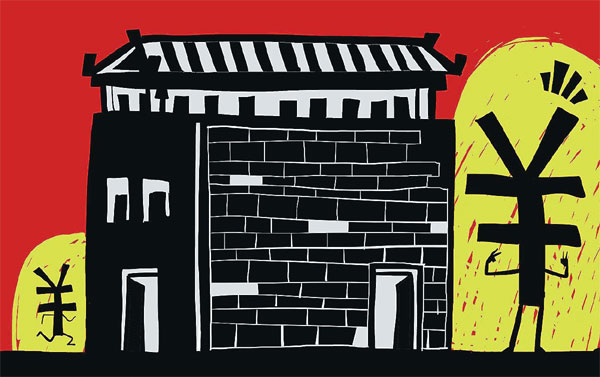Deposit plan opens door to liberalization
Updated: 2014-12-12 11:24
By Zhu Ning(China Daily Europe)
|
|||||||||||
Ensuring stability of Chinese financial system is key to next stage of reform
The People's Bank of China's recent announcement that it is seeking public feedback about its decision to introduce a deposit insurance program is an encouraging development. Such a program, first mooted 21 years ago, is likely to have significant implications for the Chinese financial system and Chinese economic growth in the coming decades.
A deposit insurance program was first implemented in the United States after the Great Depression of the late 1920s and 1930s. The US public and regulators realized that failed banks could wreak havoc on the US economy so set up a mechanism to prevent bank runs and resulting bank failures.
As a result, the Federal Deposit Insurance Corporation, which receives federal government support and provides third-party insurance for banks, was founded. The company charges banks a premium for its insurance services and in turn insures the safety of any saver's deposit at any given bank up to a limit. This mechanism not only solidifies savers' confidence in banks and the banking sector, but also provides incentives for banks to improve their operations and risk management, in order to obtain a more attractive insurance premium.
With the US experiment, deposit insurance programs have gradually become a common feature of modern banking. China's adoption of such a program is thus widely regarded as a positive step in the country's banking and financial sector reform.
On the surface, the insurance mechanism is intended to ensure the financial soundness of all Chinese households and corporations. Under the proposal all deposits up to 500,000 yuan would be fully covered. Coverage would be of more than 99 percent of deposit accounts so would protect the safety of most savers.
More importantly, the launch of a deposit insurance program comes at a timely moment. With the problem of ballooning debt facing the Chinese economy and the faltering real estate sector, how to ensure the health and stability of the Chinese financial system has become pivotal to the next stage of financial and economic reform. With the deposit insurance program, the banking sector, which now carries the bulk of social financing responsibilities, will pose less of a threat to the economy.
Another significant implication of the deposit insurance program is that it paves the way for liberalizing Chinese interest rates.
While Chinese banks compete fiercely with one another for deposit volumes, especially toward the ends of quarters and years, the banks are barred from competing directly and explicitly by offering higher interest rates. Fully liberalized interest rates would usher in head-to-head competition.
However, such liberalization would expose savers to the classic economic problem of adverse selection. As with the used car market, where people willing to sell their cars at lower prices probably know there is something wrong with their cars, banks that promise higher deposit rates probably have to do things others are unwilling or unable to do.
One theory of finance is that if a lender wants higher returns in a market, that lender takes on additional risks.
Unfortunately, because most savers focus only on comparing the deposit rate offered by different banks but ignore the risks behind some attractive rates, one possible consequence of interest rate liberalization is that the riskiest banks may end up attracting most of the savers' money.
To make things even worse, executive stock option and employee stock option plans may induce banks to take more risks than they can manage, even if the management is aware of the potential downfall.
As a result, the process of interest rate liberalization may expose many savers to risks that they are unwilling or unable to handle. Such risks may not hurt only households and savers, but also cause systemic financial risks to China's banking system.
In this regard, the launch of the deposit insurance program will require savers, especially those with balances larger than 500,000 yuan, to take responsibility for the safety of their own savings and thereby diffuse some of the increasing risks in the Chinese banking sector.
At the same time, different banks will face varying shocks as interest rates are being liberalized. Smaller banks, considered to be not as safe as the four leading state-owned banks, may witness deposit outflow after the deposit insurance program is introduced. Further, because smaller banks are considered to be riskier than larger banks, they may also face higher insurance premiums, which will subject smaller banks to double trouble through the reform.
On the bright side, such a transition in the traditional banking sector will force banks to improve their operational efficiency, and may even force some out of business.
At the same time, it is worth noting that the transparent interest rate liberalization in the main banking sector will also carry a considerable ripple effect to booming shadow banking in China. Innovative financial offerings such as trust products, peer-to-peer lending and Internet financing have become so popular in China in the past couple of years that regulators and observers have voiced concerns about the transparency and sustainability of these products.
With banks' savings rates becoming transparent and competitive, shadow banking will inevitably face banks' direct competition, which until now have been hindered by regulations on interest rates.
Indeed, once prevailing interest rates increase as a result of liberalization, every corner of the Chinese economy will feel its effect. Households will probably be the winners, enjoying higher interest rates and greater peace of mind when investing in various financial products offered by banks and bank-like financial institutions.
On the other hand, borrowers, most notably the state-owned enterprises and local government financing vehicles, may face increasing risks and pressures. Companies in sectors with excessive capacity, particularly state-owned enterprises, have been relying on cheap financing as their lifelines for survival and development. Once cheap financing is no longer available, many will have to discipline and reform themselves to survive in the new regime.
Local government financing vehicles, which until now have shouldered most of local governments' financing needs and investment projects, enjoy the implicit guarantees provided by higher-level governments and the resulting favorable access to bank lending and regulated bank rates.
When interest rates become more liberalized, the cost of financing and refinancing will increase. This may be particularly troublesome to many local governments, already feeling the pressure on their fiscal situation as a result of the cooling housing market and slowing local economies. In light of interest rate liberalization, the concentration of debt maturity and increasing financing costs may prove to be the straw that eventually breaks the camel's back.
In sum, interest rate liberalization will probably redistribute social resources between savers, banks and borrowers. Despite the benefits savers enjoy, the risk profiles of banks, trust companies, state-owned enterprises, and many local governments will all probably change drastically in the process.
Given the central role of interest rates in determining the allocation of funding, interest rate liberalization will considerably alter the landscape of the Chinese financial sector and the whole economy.
Consequently, liberalization is bound to take place at a gradual pace so as to avoid and contain potential risks. Several other major areas of financial reform, such as capital account liberalization, renminbi internationalization and development of multiple-level capital markets, may follow suit with the reform in interest rate liberalization, and will probably provide useful channels to manage additional risks and capitalize on greater reform dividends.
The author is a faculty fellow at the International Center for Finance at Yale University and deputy dean of the Shanghai Advanced Institute of Finance at Shanghai Jiao Tong University. The views do not necessarily reflect those of China Daily.

|
Zhang Chengliang / China Daily |
(China Daily European Weekly 12/12/2014 page12)
Today's Top News
Traffic normalized at occupy sites, 209 arrested
British mother jailed for terror-related posts on Facebook
More MH17 crash victims identified
Asia has new richest person
UK rolls out red carpet for Chinese shoppers
HK police start clearing Admiralty protest site
Deflation 'may force central bank's hand'
Hypersonic tests target no specific country
Hot Topics
Lunar probe , China growth forecasts, Emission rules get tougher, China seen through 'colored lens', International board,
Editor's Picks

|

|

|

|

|

|






